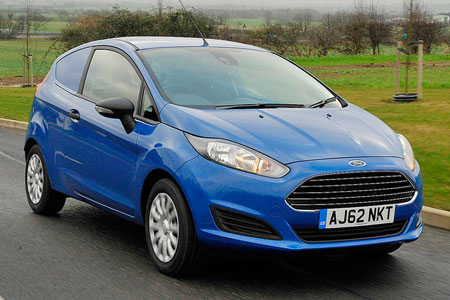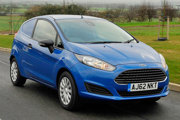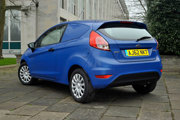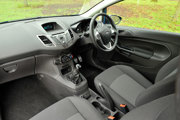Review
Small vans are becoming increasingly popular among fleets looking to downsize to save money and cut down on vehicle bangs and scrapes more common on larger vehicles.
It’s all about choosing vehicles that are fit for purpose, and this has seen a growing number of van makers enter the sector.
Ford spotted this opportunity a long time ago with its original Fiesta Van, launched shortly after the first Fiesta car in the late 1970s.
The most recent all-new model was launched in 2010, when it won the Fleet Van City Van of the Year title.
Despite being harried by a trio of high-cube arrivals in the small van sector, namely the Fiat Fiorino, Citroën Nemo and Peugeot Bipper, the Fiesta Van has managed to hold on to sales and thrive against this storm of opposition.
Indeed, the Fiesta Van commands a sturdy 63.5% of sector sales.
Now just over two years down the line, a refreshed version is about to go on sale and while the Fiesta Van can’t come anywhere near the high-cubers in terms of load volume, it certainly wins out in the driveability stakes – after all, it is a car made into a van, so can boast true car-like ride and handling.
And as many people who buy these vehicles only need room for a couple of boxes or a few small items, load space won’t be a problem anyway.
A two-year lifecycle is virtually unheard of in the van world but that’s largely down to the fact that the outgoing model was launched part-way through the Fiesta car’s lifecycle.
Ford has taken the decision to update it shortly after launching the facelifted car, no doubt conscious of the growing threat from the likes of Mercedes-Benz which has just launched its first-ever small van, the Citan.
Consequently, Ford’s entire van range is being upgraded, of which this new small contender is a part.
The Ranger has also been relaunched – winning itself in the meantime the title of Fleet Van LCV of the Year 2012 – while the Transit Custom, a new small Transit, is about to go on sale.
Later this year we’ll be seeing first examples of a new full-size Transit and Transit Connect, meaning that the entire Ford range will have changed in the space of a year.
At the Fiesta Van’s launch, Andy Barrett, Ford of Britain’s sales director, told Fleet Van: “Ford has been the UK’s best-selling van brand for 48 years and we have no intention of letting go of our lead, hence all these new models.
"We are seeing a lot of fleets downsizing to Fiesta Van for urban use as they realise the savings that can be made by using smaller vehicles.”
Barrett also revealed a new sales strategy at Ford. He said: “We used to have separate sales teams for cars and vans but now the two have joined forces.
“A lot of fleets buy cars and vans, so now fleet buyers will be able to talk to the same people for both. We believe that is the way forward.”
So exactly what has changed in the new Fiesta Van? For starters, there are some obvious changes in the bodywork which make for a smarter, cleaner look, including laser-cut headlamps incorporating LED technology and a new grille. For the first time, buyers have the option of 17-inch alloy wheels.
Inside, switchgear has been moved around and there is a new centre console – the same as the one in the new Transit Custom – and arm rest.
Under the bonnet is a new set of 1.5-litre and 1.6-litre common rail diesel engines, both built at Dagenham, which all achieve sub-100g/km CO2 emissions and fuel economy figures of 76.4mpg or better.
The 1.5-litre unit offers 75bhp while the bigger unit pumps out 95bhp.
An Econetic version features standard stop-start, lowered suspension, aero-dynamic rear undertray and wheel trims with low rolling resistance tyres. This model returns 85.6mpg on the combined cycle.
There are also two 1.25-litre petrol engines on offer for those wishing to convert to LPG, offering 60bhp and 82bhp respectively. CO2 emissions of the higher output engine are 120g/km, with fuel efficiency of 52.3mpg.
In the back, the Fiesta Van offers 1.0 cubic metres of loadspace and there is a standard half-height bulkhead with mesh above, along with a wipe-clean floor and four load lashing eyes.
Payload hovers around 500kg, depending on which model is chosen.
On the technical side, the new model has as an optional extra the Ford SYNC system with emergency assistance, which directly connects the occupants to local emergency services after an accident – it even uses the right language for the country in which it is being driven.
There is also a safety system called Active City Stop, which is designed to help avoid low-speed accidents by applying the brakes if a solid object is detected in front of the van.
It is offered alongside other convenience features such as Hill Start Assist, Easy Fuel and Rear View Camera.
Prices range from £10,980 to £13,470 ex-VAT.
Behind the wheel
Many fleets are beginning to realise that a lot of their staff are driving around in bigger (and more costly) vehicles than they really need.
A smaller, fit-for-purpose option reduces fuel bills, van prices and is less likely to be knocked by drivers compared to a larger van.
This new Fiesta Van offers an ideal alternative for anyone looking to downsize. The perky little performer rides and handles exactly like its car brother.
And just look at those fuel economy figures – 85mpg if you choose the Econetic version.
Our test drive in the 1.6-litre Econetic model took place in the wilds of Oxfordshire on some back roads with a bit of M40 thrown in for good measure and we were left with an enormous amount of respect for this mini-contender.
It looks great, as you can see from the pictures, and inside the seats are sporty and comfortable, with lots of side support. It was fine for me though larger drivers might find it a squeeze.
Meanwhile, despite its diminutive size, there is plenty of legroom and the steering wheel adjusts for height.
As expected, storage space is at a premium but at least there are two coffee cup holders in the centre console.
The cargo area is good and square and the wipe-clean floor is a welcome extra, although there is a fair-sized lip at the rear so loads can’t simply be slid in and out.
The diesel powerplant is highly refined and, despite the fact that there is only a mesh bulkhead, hardly any noise emanates from the back.
The Fiesta Van is a delight to drive.
Gears snick into place smoothly, our 95bhp engine proved lively, even on the hills, and handling was pin-sharp on the bends.
Our only complaint is that Electronic Stability Control (ESC) remains on the options list at £400 on Base and Trend models.
Making this wonderful safety system a standard fitment across the range would have really put the Fiesta Van ahead of the rivals.
Verdict
It looks great, it drives brilliantly and it’s a real fuel miser.
As long as you don’t need more than one cubic metre of loadspace, the new Fiestavan will put a smile on the face of both driver and fleet operator.



















